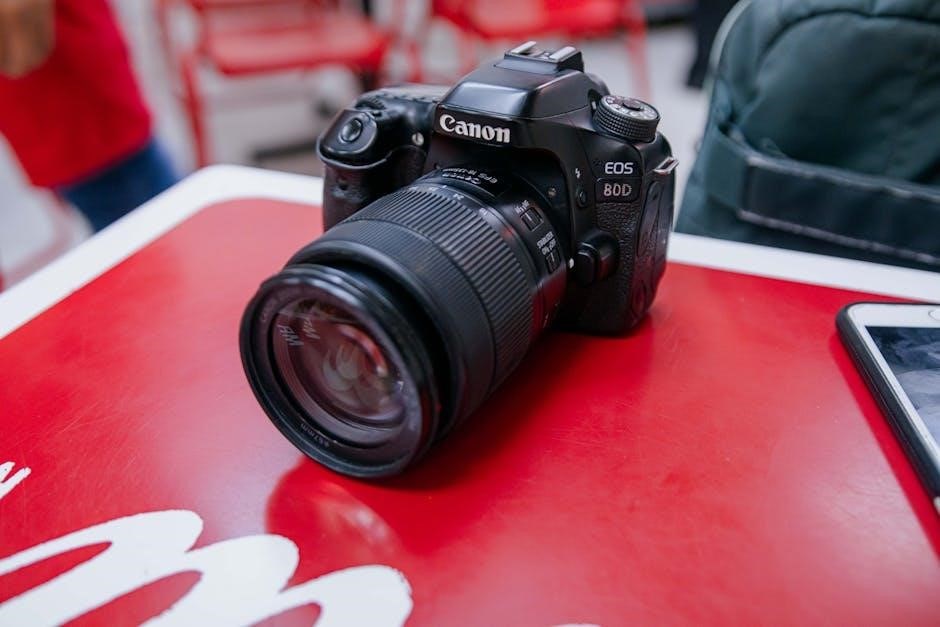The Canon AE-1 Program is a legendary 35mm film SLR camera introduced in 1981, known for its user-friendly design and versatility, catering to both amateurs and professionals․
1․1 Overview of the Camera
The Canon AE-1 Program is a 35mm film SLR camera introduced in 1981, designed for both amateur and professional photographers․ It features automatic exposure modes, manual override, and compatibility with Canon FD lenses․ The camera is known for its intuitive design, built-in flash synchronization, and versatility in various shooting conditions․ Its popularity stems from its ease of use and advanced features, making it a timeless choice for film photography enthusiasts․ The AE-1 Program remains a iconic model in Canon’s history․
1․2 Historical Significance
The Canon AE-1 Program, released in 1981, marked a significant milestone in photography history․ It built on the success of the A-1, offering advanced features like automatic exposure modes and manual overrides․ Its user-friendly design made it accessible to both amateurs and professionals, solidifying its place as a cult classic․ The camera’s versatility and reliability influenced subsequent Canon models and remains a beloved choice among film photography enthusiasts, highlighting its enduring legacy in the industry․
1․3 Key Features
The Canon AE-1 Program features a through-the-lens light metering system, three operation modes (Program, Shutter-Speed Priority, and Manual), and compatibility with Canon FD lenses․ It includes a self-timer, multiple exposure capabilities, and flash synchronization with Speedlites like the 155A․ The camera’s design combines durability with ergonomic controls, offering intuitive access to settings․ These features made it a versatile tool for photographers, blending automation with creative control, and contributing to its popularity among enthusiasts and professionals alike․

Camera Specifications
The Canon AE-1 Program is a 35mm SLR film camera with FD lens compatibility, offering shutter speeds up to 1/1000th of a second and automatic aperture control․
2․1 Type of Camera
The Canon AE-1 Program is a 35mm single-lens reflex (SLR) film camera, featuring electronic aperture control and interchangeable FD-mount lenses․ It offers three operating modes: Program, Shutter-Speed Priority, and Manual․ The camera’s design combines durability with user-friendly controls, making it accessible to both novice and professional photographers․ Its compact size and lightweight construction enhance portability, ensuring it’s ready for various shooting scenarios․ The AE-1 Program is celebrated for its reliability and versatility in capturing high-quality images․
2․2 Lens Compatibility
The Canon AE-1 Program is compatible with Canon’s FD-mount lenses, offering a wide range of focal lengths and aperture options․ The FD series includes prime and zoom lenses, ensuring versatility for various photography needs․ The camera supports automatic aperture control when used with FD lenses, enhancing ease of use․ Compatibility with the FD system allows photographers to choose from a diverse selection of lenses, making the AE-1 Program adaptable for different shooting scenarios and creative goals․
2․3 Shutter Speed Range
The Canon AE-1 Program features a versatile shutter speed range of 1/1000th of a second to 1 second in Program and Shutter-Speed Priority modes․ Manual mode extends this range to include Bulb (B) for long exposures․ This range allows photographers to capture sharp action shots, create artistic motion blur, or handle low-light conditions effectively․ The camera’s electronic shutter control ensures precise and consistent exposure settings, making it suitable for a variety of shooting environments and techniques․
2․4 Aperture Control
The Canon AE-1 Program offers precise aperture control, allowing photographers to adjust lens openings for depth of field and exposure․ In Program mode, the camera automatically selects the aperture based on the shutter speed․ Manual mode enables direct aperture adjustment via the lens ring, with a range from f/1․4 to f/16, depending on the lens․ This flexibility ensures creative control over lighting and composition, catering to both automatic and manual shooting preferences․
Camera Design and Layout
The Canon AE-1 Program features a user-friendly design with a compact, ergonomic build, offering intuitive controls and a durable construction, making it easy to handle for both amateurs and professionals․
3․1 Top View Components
The top view of the Canon AE-1 Program features a shutter speed dial with modes like Program, Manual, and Shutter-Speed Priority․ An LCD panel displays exposure settings, while the frame counter tracks exposures․ The ISO indicator shows the film speed, and the on/off switch prevents accidental shutter release․ These components are arranged ergonomically, ensuring intuitive control and ease of use for photographers of all skill levels․
3․2 Bottom View Components
The bottom of the Canon AE-1 Program includes a tripod socket for stable mounting, a motor drive connector for attaching an external winder, and a battery compartment․ These features enhance functionality and convenience, ensuring smooth operation during extended shoots or when using additional accessories like motor drives for faster film advancement․
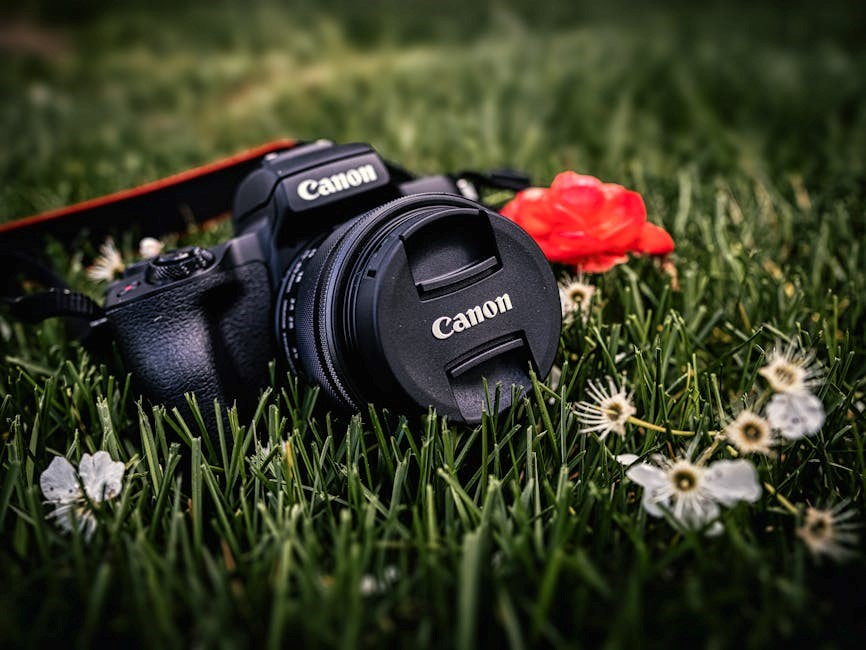
Operation Modes
The Canon AE-1 Program offers three versatile operation modes: Program Mode for automatic settings, Shutter-Speed Priority Mode for manual control, and Manual Mode for full creative control․
4․1 Program Mode
In Program Mode, the Canon AE-1 Program automatically sets both shutter speed and aperture for optimal exposure, making it ideal for beginners or quick shooting situations․ The camera selects from a range of EV1 to EV18, ensuring balanced results․ This mode is perfect for everyday photography, as it handles lighting conditions effortlessly․ Users can rely on the camera’s advanced metering system for accurate exposures․ For added flexibility, manual overrides are possible by adjusting the aperture ring or shutter speed dial, allowing for creative adjustments while maintaining automatic features․ This mode strikes a balance between convenience and control, making it versatile for various photography needs․
4․2 Shutter-Speed Priority Mode
In Shutter-Speed Priority Mode, users set the desired shutter speed, and the camera automatically adjusts the aperture for proper exposure․ This mode is ideal for controlling motion effects, such as freezing action or creating blur․ Photographers can choose speeds from 1/1000th of a second to 30 seconds․ The camera’s metering system ensures accurate aperture settings, making it a great option for those who want creative control over motion and lighting without manual aperture adjustments․ A tripod is recommended for slower speeds to avoid camera shake․
4․3 Manual Mode
In Manual Mode, photographers gain full control over both shutter speed and aperture, allowing precise adjustments to suit creative preferences․ This mode is ideal for experienced users who prefer to override automatic settings․ The camera’s metering system provides guidance, but the user must set exposures manually․ LED indicators in the viewfinder assist in achieving optimal exposure․ Manual Mode is perfect for experimenting with lighting and depth of field, offering unparalleled creative control for discerning photographers․ This mode requires a good understanding of exposure principles for best results․

Loading Film
Open the camera back, attach the film to the spool, and advance it until the perforations align․ Close the back and wind the film to the first frame․
5․1 Film Loading Process
Open the camera back by pulling the rewind knob․ Attach the film leader to the spool, ensuring it aligns with the red mark․ Close the back and wind the film until it stops․ Advance the film to the first frame by turning the winding lever․ The film is now ready for shooting․ Ensure the frame counter starts at “1” to confirm proper loading․
5․2 Film Speed Settings (ASA)
Set the film speed using the dial on the top of the camera․ Ensure the ASA/ISO matches the film cartridge; Turn the dial until the correct value aligns with the mark․ The camera uses this setting for exposure calculations․ Proper alignment ensures accurate metering and optimal photo results․ Always refer to the film cartridge for the correct ASA/ISO rating before adjusting the dial․ This step is crucial for achieving correctly exposed images every time․
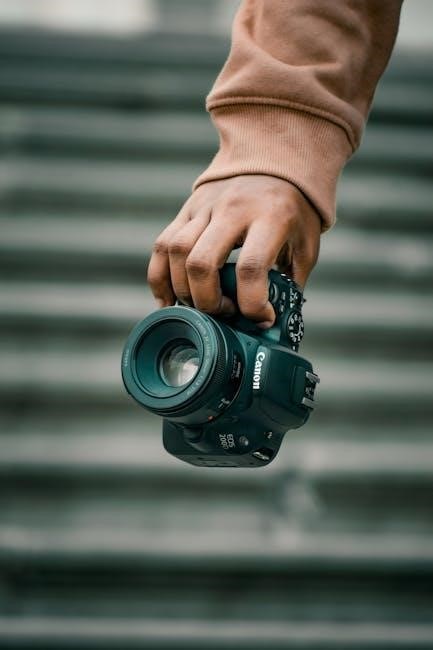
Viewfinder Display
The viewfinder displays essential shooting information, including LED indicators for exposure settings, flash status, and camera shake warnings, ensuring precise control over your photography․
6․1 InformationDisplayed
6․1 Information Displayed
The viewfinder displays aperture, shutter speed, and LED indicators for program mode, flash status, and camera shake warnings․ It also shows exposure settings and flash readiness, ensuring precise control․ The P LED confirms program mode, while blinking LEDs alert to potential issues like low light or incorrect settings, helping photographers make necessary adjustments for optimal results․
6․2 LED Indicators
The viewfinder features LED indicators to guide photographers․ The P LED lights in program mode, confirming automatic settings․ Flash readiness is indicated by a dedicated LED, ensuring optimal timing․ A blinking P warns of camera shake when shutter speed is too slow, prompting the use of a tripod or flash․ These indicators provide real-time feedback, helping users adjust settings for precise control over their photography․ LED signals enhance operational ease and efficiency․

Flash Photography
The Canon AE-1 Program supports flash photography with compatibility for Speedlites like the 155A, ensuring versatile lighting control and enhancing creative possibilities in various shooting scenarios․
7․1 Built-in Flash
The Canon AE-1 Program does not feature a built-in flash but is compatible with external Speedlites like the 155A․ When connected, the flash synchronizes with the camera’s metering system, providing balanced lighting․ The flash readiness is indicated in the viewfinder, ensuring proper illumination in low-light conditions․ This setup allows for versatile and creative flash photography, enhancing the camera’s functionality for various shooting scenarios;
7․2 Compatible Speedlites
The Canon AE-1 Program is compatible with a range of external Speedlites, including the 133A, 177A, 188A, 199A, 533G, and 577G․ These units integrate seamlessly with the camera’s metering system, providing automatic flash exposure control․ When connected, the Speedlites synchronize with the camera’s shutter, ensuring proper illumination․ The camera’s viewfinder includes an LED indicator to confirm flash readiness, making it easy to use these accessories for consistent and professional results in various lighting conditions․
Advanced Features
The Canon AE-1 Program offers advanced features like a self-timer for delayed shutter release and multiple exposures, enabling creative techniques and precise control over image capture․
8․1 Self-Timer
The Canon AE-1 Program features a self-timer for delayed shutter release, ideal for minimizing camera shake or including the photographer in group shots․ Activated via a dedicated button, it provides a 10-second countdown, indicated by a blinking LED in the viewfinder․ Once the timer expires, the shutter releases automatically․ This feature enhances versatility and ensures sharp images even when the photographer is part of the scene․
8․2 Multiple Exposures
The Canon AE-1 Program allows for multiple exposures, enabling photographers to create unique, layered images on a single frame․ Activated in manual mode, this feature is achieved by pressing the frame counter reset button before advancing the film․ This process allows users to capture overlapping images, offering creative control and artistic expression․ The camera does not automatically advance the film, ensuring complete control over the multiple exposure process․
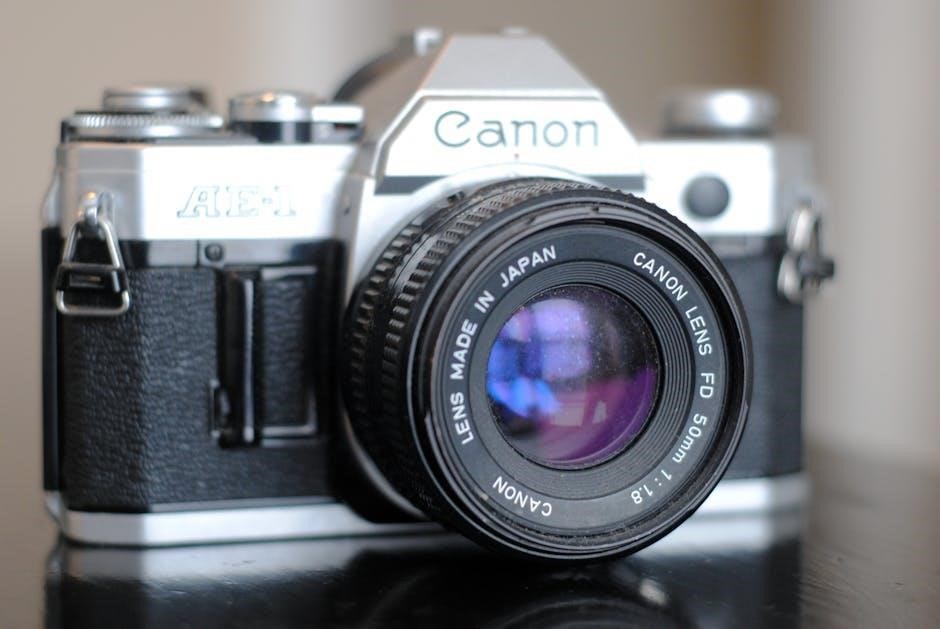
Maintenance and Care
Regularly clean the camera’s mirrors and lenses with a soft cloth to prevent dust buildup․ Store in a dry, cool place to maintain functionality and longevity․
9․1 Cleaning the Camera
Use a soft, dry cloth to gently clean the camera body, viewfinder, and lenses․ Avoid harsh chemicals or abrasive materials that could damage surfaces․ For mirrors and internal components, a specialized cleaning brush or compressed air can be used․ Regular cleaning prevents dust buildup and ensures optimal performance․ Always handle the camera with care to avoid scratches or damage to sensitive areas․ Cleaning is essential for maintaining the camera’s functionality and longevity over time․
9․2 Storing the Camera
Store the Canon AE-1 Program in a cool, dry place away from direct sunlight to prevent damage․ Use a protective case or bag to shield it from dust and moisture․ Remove batteries to avoid corrosion and ensure the camera remains in a powered-down state․ Proper storage helps maintain the camera’s functionality and prevents deterioration of its components over time, ensuring it remains ready for use when needed․
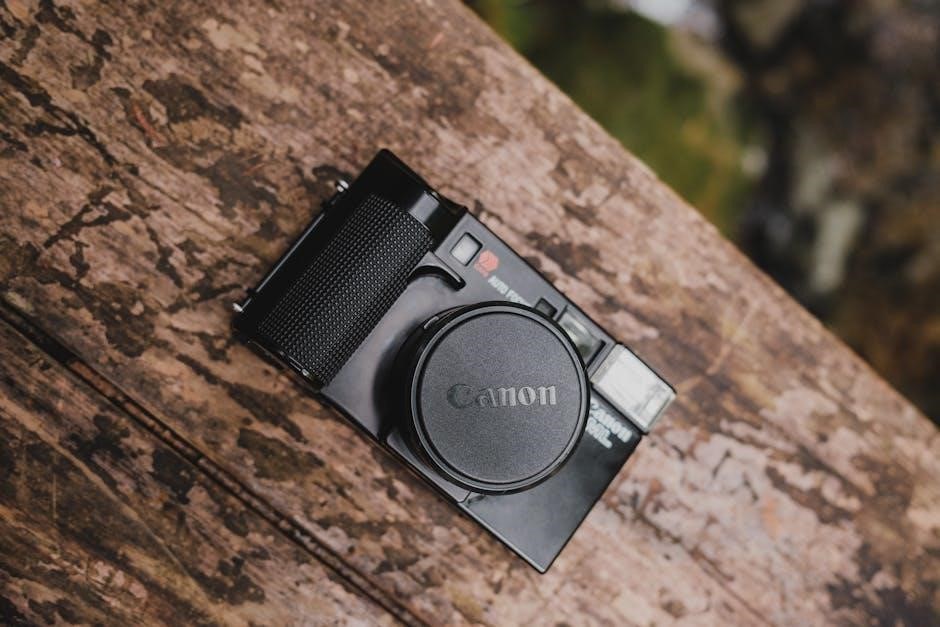
Troubleshooting
Common issues include err99, camera shake warnings, and battery drain․ Solutions involve cleaning contacts, using a tripod for stability, and checking battery health regularly․
10․1 Common Issues
Common issues with the Canon AE-1 Program include err99 errors, camera shake warnings, inconsistent exposures, and battery drain․ Mechanical failures, such as stuck shutters or faulty light meters, can also occur․ Additionally, users may encounter issues with film loading, improper flash synchronization, or aperture ring malfunctions․ Regular maintenance and proper handling can help prevent many of these problems, ensuring optimal performance of the camera․
10․2 Solutions and Tips
For common issues like err99 errors, perform a hard reset by removing the battery and film․ To address camera shake, use a tripod or flash․ For inconsistent exposures, ensure proper film speed settings and clean the light meter․ Replace batteries regularly and avoid extreme temperatures․ For mechanical issues, consult a professional technician․ Proper maintenance, such as cleaning the camera and lenses, can prevent many problems and extend the camera’s lifespan․
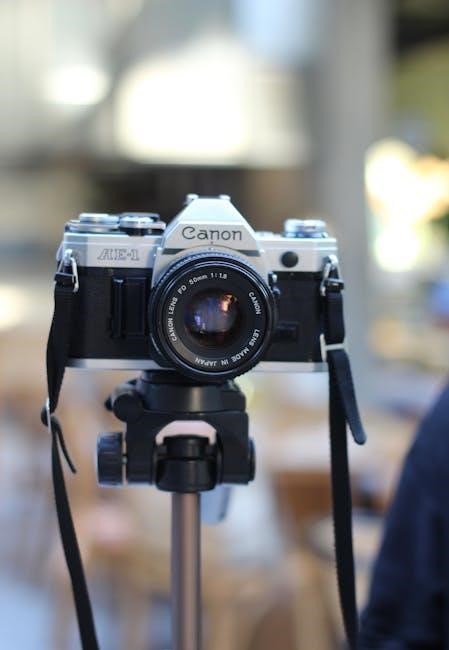
Impact and Legacy
The Canon AE-1 Program became a favorite among photographers, influencing subsequent models like the A-1․ Its popularity and versatility solidified its place in photography history, enduring as a beloved classic․
11․1 Popularity Among Photographers
The Canon AE-1 Program gained immense popularity for its user-friendly design, versatility, and automatic exposure system․ Its ease of use appealed to both amateurs and professionals, making it a favorite choice․ The camera’s intuitive controls and reliable performance solidified its reputation as a cult classic, remaining a beloved tool for photographers long after its release․ Its influence is evident in later Canon models, ensuring its legacy in photography history․
11․2 Influence on Subsequent Models
The Canon AE-1 Program set a benchmark for future SLR cameras, influencing the development of subsequent models․ Its advanced features and user-friendly design inspired improvements in automation and versatility․ The camera’s success prompted Canon to refine its A-series, leading to models like the A-1, which incorporated additional modes and enhanced capabilities․ The AE-1 Program’s legacy is evident in its lasting impact on Canon’s camera evolution and design philosophy․

Resources and Further Reading
Access the official Canon AE-1 Program manual on Canon’s website or platforms like ManualsLib․ Explore community forums and online guides for detailed insights and troubleshooting tips․
12․1 Online Manuals
The Canon AE-1 Program manual is widely available online in PDF format․ Platforms like ManualsLib and Butkus’s website offer free downloads, providing detailed instructions on camera features, operation modes, and maintenance․ The manual covers aperture, shutter speed, and flash settings, ensuring comprehensive guidance for photographers․ It’s an essential resource for mastering the camera’s capabilities and troubleshooting common issues; Downloading the manual is a convenient way to access information anytime, anywhere․
12․2 Community Forums
Community forums dedicated to the Canon AE-1 Program provide a wealth of knowledge and support; Photographers share tips, troubleshooting advice, and personal experiences․ These forums are ideal for users seeking hands-on guidance or inspiration․ Discussions often cover topics like optimal lens pairings, flash photography, and maintenance tips․ They serve as a valuable resource for both beginners and experienced photographers looking to maximize their camera’s potential and enhance their photography skills․
The Canon AE-1 Program remains a timeless classic, offering reliability and versatility for photographers of all levels․ Its comprehensive manual ensures mastery of its features, making it a beloved choice for film photography enthusiasts․
13․1 Final Thoughts
The Canon AE-1 Program is a timeless classic, celebrated for its intuitive design and versatility․ Its ease of use, combined with advanced features like multiple operation modes, makes it a favorite among photographers of all skill levels․ The camera’s durability and compatibility with a wide range of lenses and accessories further enhance its appeal․ With the comprehensive manual guiding users, the Canon AE-1 Program remains a cherished tool for mastering film photography, ensuring its lasting legacy in the world of photography․
13․2 Encouragement to Explore
Exploring the Canon AE-1 Program is a rewarding journey that unlocks its full creative potential․ Experiment with its intuitive modes, discover the joy of manual controls, and master the art of film photography․ Dive into its features, from program AE to manual overrides, and embrace the hands-on experience․ With each click of the shutter, you’ll gain a deeper understanding of light and composition, inspiring you to capture the world from unique and imaginative perspectives․
Where to Find the Manual
The Canon AE-1 Program manual is available on the official Canon website and third-party sources like ManualsLib․ It can also be downloaded as a PDF for offline use․
14․1 Official Canon Website
The Canon AE-1 Program manual is available on the official Canon website․ Users can easily download the PDF manual for offline access, ensuring convenience and reliability․ The official site provides accurate and comprehensive information, making it the primary source for understanding the camera’s features and operation․ Visit the official Canon website to access the manual directly and explore additional resources for optimal camera usage․
14․2 Third-Party Sources
Besides the official Canon website, the Canon AE-1 Program manual can be found on third-party platforms like ManualsLib and Butkus․ These sites offer free downloads of the manual, making it accessible to a wider audience․ Additionally, online forums and photography communities often share scanned versions of the manual, providing alternative access for users who prefer external resources․ These sources are particularly useful for those seeking supplementary materials or troubleshooting guides․
